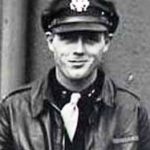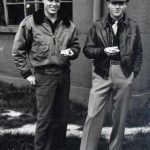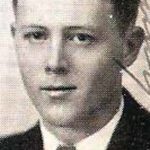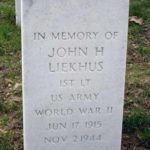John H. Liekhus – June 17, 1915 – Nov. 2, 1944
 It’s taken 73 years for Anaheim’s Class of 1934 Colonist John Liekhus to return home. His remains were recently recovered from farmland in Germany where the B-17 he piloted crashed on Nov. 2, 1944, according to a press release from Defense POW/MIA Accounting Agency (DPAA).
It’s taken 73 years for Anaheim’s Class of 1934 Colonist John Liekhus to return home. His remains were recently recovered from farmland in Germany where the B-17 he piloted crashed on Nov. 2, 1944, according to a press release from Defense POW/MIA Accounting Agency (DPAA).
He and his crew members will be buried next year with full military honors at Arlington National Cemetery in Virginia.
First Lt. John Liekhus was a flyer with the 323rd Bombardment Squadron, 91st Bombardment Group, Eighth Air Force.
Liekhus and his crew were on a bombing mission to Merseburg, Germany, when their plane was hit by flak. As the B-17 fell out of formation, German fighters attacked. Witnesses reported seeing the aircraft burst into flames and descend rapidly. It crashed two kilometers (just over one mile) southwest of the town of Barby, according to the DPAA .
Facts that have emerged from the investigation include this story of the crash showing the immense courage of Liekhus and his crew:
When he realized his plane was going down, Liekhus ordered his nine-member crew to bail. Co-pilot Robert Wisor, who was captured after bailing out of the doomed plane, gave the following testimony in an Army “Casualty Questionnaire” dated Feb. 27, 1946, obtained from the Library of Congress:
“Second Lt. Robert Sambo (bombardier) bailed out of the plexiglass nose (which was shot out) before the plane went into a tail spin.” (Sambo survived the war as a POW.) “Staff Sgt. B. Lombardi (tail gunner) jumped out of the tail escape hatch at approximately the same time as the bombodier.” (Lombardi also became a POW.)
A crew member who died in the crash tried to save the flight navigator by pushing him through the nose of the stricken bomber. The navigator died before hitting the ground and his body was recovered a few months later. The five other crew members, including Liekhus, were declared missing in action.
In January 1951, the American Graves Registration Command (AGRC) concluded that the five unaccounted-for crew members perished in the crash and the location of their remains was unknown.
That conclusion changed, however, after Liekhus’ great nephew, Michael Cushing, a retired Anaheim physician, began researching the crash, contacting survivors and encouraging the US Government to re-open the investigation. With the help of the German government, the DPAA was able to recover trace remains of Liekhus and his crew members. They will be buried next year with full military honors at Arlington National Cemetery in Virginia.
First Lieutenant Liekhus was 29 years old when he was piloting the B-17G flying fortress nicknamed “Bomber Dear” on a strategic mission to bomb Merseburg oil refineries. Ultimately, the denial of refined petroleum products would be instrumental in ending Hitler’s pursuit of world domination.
A ring of 400 anti-aircraft guns, twice the number protecting Berlin, had been brought into the Merseburg refinery corridor in a desperate attempt to protect Germany’s dwindling petroleum supply. The guns took their toll in men and machines.
Anaheim High Class of 1939 Bruce Alexander met the same demise as Liekhus. A second lieutenant, Alexander was also attached to the 8th Air Force. He died a month after Liekhus on Dec. 6, 1944, after being shot down during a Merseburg raid.
 Liekhus’ brother Leonard, also a decorated WWII bomber pilot, was the last to see John alive. Another brother, Gene “Eugene,” served in WWII as well. They were the sons of Joseph B. and Gertrude E. Liekhus, who brought their family to Anaheim in the early ‘30s after losing their farm in Cedar Rapids, Neb., during the Great Depression.
Liekhus’ brother Leonard, also a decorated WWII bomber pilot, was the last to see John alive. Another brother, Gene “Eugene,” served in WWII as well. They were the sons of Joseph B. and Gertrude E. Liekhus, who brought their family to Anaheim in the early ‘30s after losing their farm in Cedar Rapids, Neb., during the Great Depression.
 When the Liekhus family arrived in Anaheim the population was close to 10,000 and the student population at Anaheim High was approximately 900, including freshman, sophomores, juniors and seniors. By the time the war broke out in the 1940s, Anaheim’s population increased only 3 percent.
When the Liekhus family arrived in Anaheim the population was close to 10,000 and the student population at Anaheim High was approximately 900, including freshman, sophomores, juniors and seniors. By the time the war broke out in the 1940s, Anaheim’s population increased only 3 percent.
Anaheim High lost 35 known graduates in WWII. Other students were removed from the student body after their families were deported to Japanese relocation camps.
Fortunately for the Liekhus family, their other two sons both returned home, and another son survived the Korean War. Gene, who resides in Washington state, is John’s only living brother. His only living sister is Trudy “Gertrude” Reynolds, age 91, who lives in Redondo Beach. Other siblings included sisters Henrietta, Irene, Helen, and Jeanette “Jean.”
The Liekhus home at 617 S. Helena Street was not the only home with a Gold Star service flag in the front window, indicating that their son had given the ultimate sacrifice for his country.
 Families of other Anaheim boys were also were reported missing in action and their bodies never recovered. Bomber pilot Mark Anderson (Class of 1934), paratrooper Ben G. Foland (Class of 1935), infantryman Rex Middleton Woodward (Class of 1930), and infantryman Jack Skinner (Class of 1930) are other Colonists listed on the Henri-Chapelle Tablets of the Missing at the American Cemetery in Belgium. Some 73 years later, a rosette will be placed on the tablet next to Liekhus’ name to indicate his remains have been found.
Families of other Anaheim boys were also were reported missing in action and their bodies never recovered. Bomber pilot Mark Anderson (Class of 1934), paratrooper Ben G. Foland (Class of 1935), infantryman Rex Middleton Woodward (Class of 1930), and infantryman Jack Skinner (Class of 1930) are other Colonists listed on the Henri-Chapelle Tablets of the Missing at the American Cemetery in Belgium. Some 73 years later, a rosette will be placed on the tablet next to Liekhus’ name to indicate his remains have been found.
Anaheim High is making sure the service and lives of these fallen Colonists and Anaheim sons and daughters are remembered.
On Nov. 7, 2013, the Anaheim High football program honored Colonist veterans during an “Honor Game.” During the half-time tribute, families of the fallen were presented with specially designed jerseys worn by the players.
AHS varsity player Juan Bocardo wore jersey #60 imprinted with Liekhus’ name. Liekhus also played football for Anaheim High, as well as basketball and served on the Deportment Committee. After graduating from Anaheim, John went on to work for Douglas Aircraft Co. in Long Beach. When the United States entered WWII, John was considered an “essential war worker” but talked his boss in letting him enlist in the Army.
The bravery of Liekhus and his Colonist classmates will never be forgotten.




